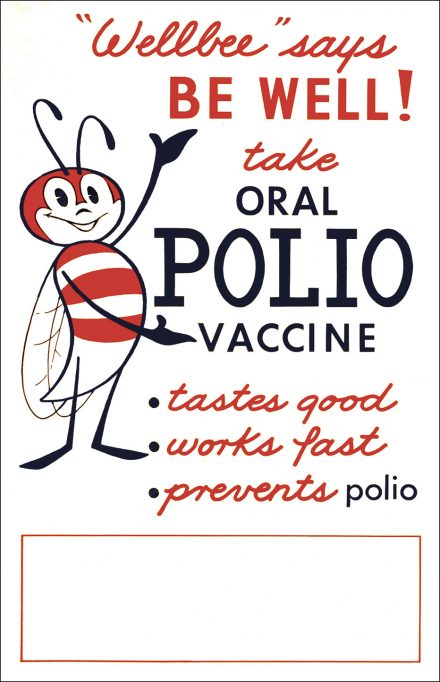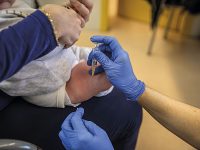
Wellbee («the wellness bee») was the national public health symbol of the US Centers for Disease Control and Prevention. In the picture, a 1963 poster featuring the character. Wellbee encouraged people to get inoculated with the oral polio vaccine./ CDC/ Mary Hilpertshauser
In summer 2021, the WHO reported that the eradication of the poliovirus has, once again, taken a small step backwards. Eliminating this enterovirus is a technically achievable goal, but it is resisting year after year. In 2018, only 138 cases were documented worldwide, many of them in Afghanistan and Pakistan, compared to 1,226 in 2020.
During 2020, the COVID-19 pandemic forced the suspension of local polio vaccination campaigns for a few months to protect vulnerable communities from the new viral threat. But after the pause, they resumed vigorously in some fifty countries and the Global Polio Eradication Initiative has developed a new strategy for the 2022–2026 period, although the date has now been displaced with the return to power of the Taliban in Afghanistan.
The two existing polio vaccines were invented in the 1950s. They differ mainly in the way they are administered and the type of immunity they provide. Jonas Salk invented the inactivated polio vaccine (IPV) in 1952. It is a non-infectious virus vaccine, i.e., it is made from virions that have been cultured but have undergone a formalin process to inactivate them. The Salk vaccine is administered by parenteral injection and provides immunity through plasma antibodies. It is a safe vaccine that does not protect against infection, but prevents progression to high viraemia if infection occurs, and thus avoids the risk of developing the disease.
The second is the oral polio vaccine (OPV). It was invented by Albert Sabin around 1957. It is an attenuated virus vaccine, i.e., live but weakened viruses with significant replication difficulties that cause a very harmless type of disease. They are also obtained through culture, but unlike the IPV vaccine, they do not completely lose their infectious capacity, although it is very low. They are administered orally. Remember that poliovirus is an orofecal virus that enters the body through the digestive system and finds entry receptors in the cells of the intestinal mucosa.
«Eliminating the polio virus is a technically achievable goal, but it is resisting year after year»
The oral polio vaccine is easier to administer and acts on the first line of defence, the intestinal cells, where it generates highly effective humoral and cell-mediated immunity that can last a lifetime. The oral attenuated vaccine is considered more effective than the inactivated vaccine, although early versions occasionally generated a type of vaccine-derived polio. The current versions have solved this safety problem. In fact, if humanity harbours the dream of eradicating this intestinal virus, it is thanks to this oral vaccine.
At the time of writing this section, all vaccines tested by the world’s drug agencies against the pandemic coronavirus are for parenteral injection. They do not completely prevent SARS-CoV-2 infection, but they are showing effective protection against the most severe forms of the disease. They share some characteristics with the attenuated polio vaccine, keeping in mind that they are technologically very different vaccines, and so are the two viruses.
In Spain, a team of CSIC scientists is in the process of developing a vaccine for intranasal administration. In other words, a vaccine that would act on the first line of defence. The aim of this vaccine is to generate neutralising antibodies in the respiratory cells to make it difficult for the virus to enter the body; this would stop the virus from infecting the body at the point of entry and prevent the disease.
The idea of a first-line vaccine against SARS-CoV-2 is well-founded and promising. We wish you luck and sufficient funding.





